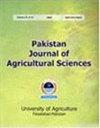改进的N2O微电极校准方法显著提高了传感器的灵敏度
IF 0.6
4区 农林科学
Q3 AGRICULTURE, MULTIDISCIPLINARY
引用次数: 0
摘要
微型传感器在测量土壤一氧化二氮(N2O)排放方面具有很大的潜力。然而,由于其在低含水量土壤上获取电信号的灵敏度较低,在半干旱农业生态系统中的研究很少。此外,N2O微电极的应用研究主要集中在土壤含水量较高的沼泽田、水田和废水中。为了表征传感器信号的边界(上下),通常使用不含N2O的纯净水作为校准介质对电极进行校准。然而,纯净水和土壤浸出液的物理和化学性质有很大的不同。在本研究中,我们改进并验证了一种基于选择合适介质和最佳电解质浓度的微电极校准方法。此外,我们采用改进的微电极校准方法,在30 d的培养实验中连续观察土壤柱的N2O通量。结果表明,与目前的方法相比,微电极校准有了显著的改进,土壤溶液被验证为校准介质,最佳电解浓度为7:1-8:1,以水/土比表示。不同肥力土壤的N2O排放量也有显著差异。本研究有助于建立低水分条件下土壤微环境N2O排放的微电极定标方法,也为农业生态系统N2O减排策略的管理实践提供参考本文章由计算机程序翻译,如有差异,请以英文原文为准。
The improved N2O microelectrode calibration method significantly improves the sensitivity of the sensor
Micro sensors have large potential to measure soil nitrous oxide (N2O) emissions. However, because of its low sensitivity to get the electrical signals on soil with low moisture content, little research has been conducted in semi-arid agro-ecosystem. Moreover, the use of N2O microelectrode studies were largely focused on the marshy fields, paddy fields and waste waters with high soil moisture content. In order to characterize the boundary of the sensor signal (upper and lower), purified water without N2O is usually used as the calibration medium to calibrate the electrode. However, the physical and chemical properties of purified water and soil leaching solutions are very different. In this study, we improved and verified a microelectrode calibration method based on selecting appropriate media and optimal electrolyte concentration. In addition, we applied the improved microelectrode calibration method to continuously observe N2O flux from the soil column in a 30-day-long incubation experiment. The results pointed to noteworthy improvement of the microelectrode calibration compared to the current method, with soil solution validated as a calibration medium at optimal electrolytic concentration of 7:1-8:1, expressed as water/soil ratio. The emission of N2O from soil with different soil fertility were also significantly different. Our research is beneficial to establish the microelectrode calibration method of N2O emission under low moisture conditions from soil microenvironment, and also points on management practices of agro-ecosystem for N2O mitigation strategies
求助全文
通过发布文献求助,成功后即可免费获取论文全文。
去求助
来源期刊

Pakistan Journal of Agricultural Sciences
AGRICULTURE, MULTIDISCIPLINARY-
CiteScore
1.80
自引率
25.00%
发文量
18
审稿时长
6-12 weeks
期刊介绍:
Pakistan Journal of Agricultural Sciences is published in English four times a year. The journal publishes original articles on all aspects of agriculture and allied fields.
 求助内容:
求助内容: 应助结果提醒方式:
应助结果提醒方式:


